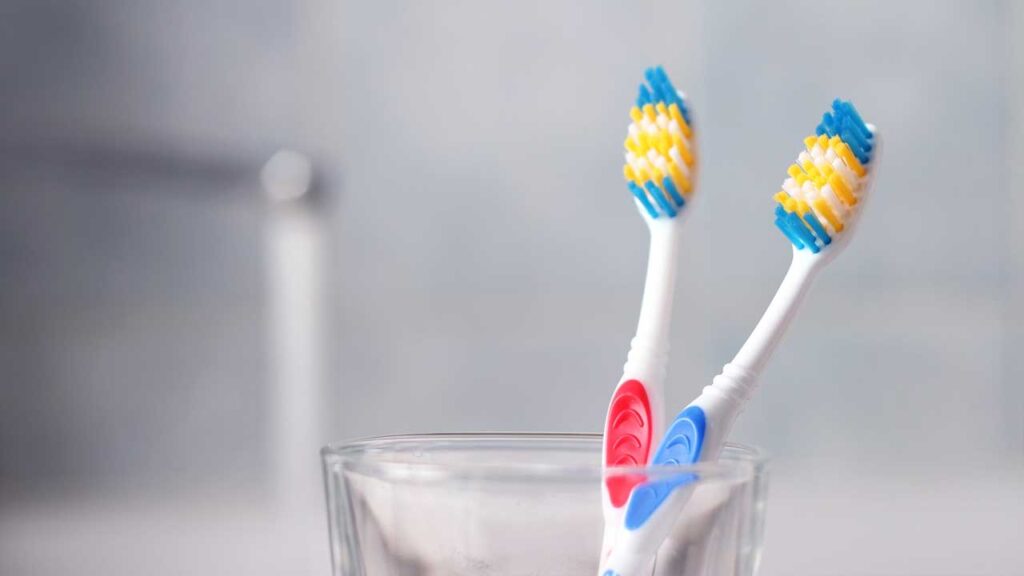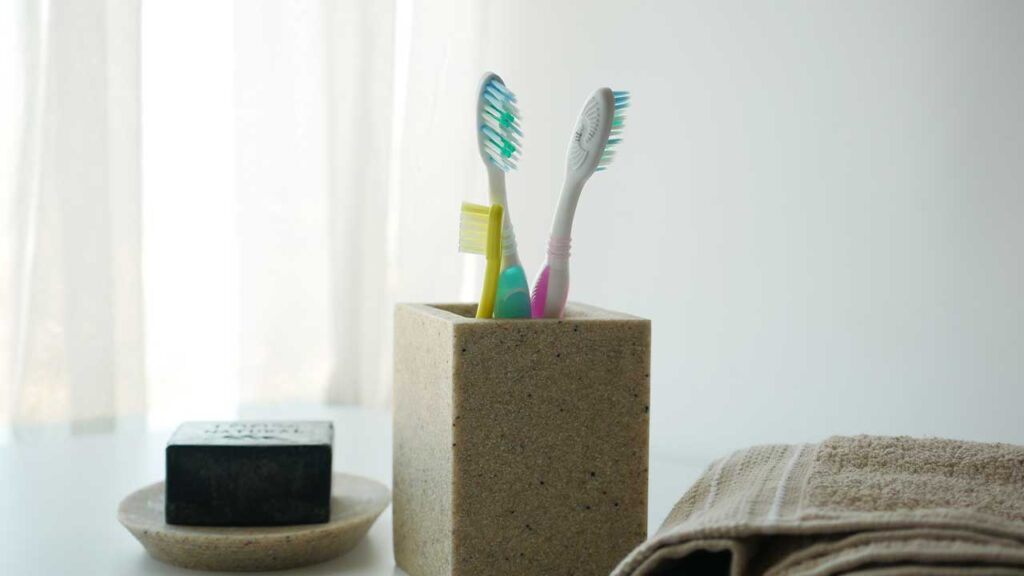A toothbrush stands or holder is a device that holds your toothbrush upright and prevents it from touching other surfaces. It can help keep your toothbrush clean, dry, and hygienic. It can also improve the appearance and organization of your bathroom.
However, not all toothbrush stands are created equal. There are different types of toothbrush stand materials, each with its own pros and cons. In this article, we will compare the most common toothbrush stand materials and help you choose the best one for your needs. You will learn:
- What are the different types of toothbrush stand materials?
- What are the pros and cons of each material?
- How to choose a toothbrush stand material based on your preferences and budget?
- How to clean and maintain your toothbrush stand
By reading this article, you will gain valuable and right information about toothbrush stand materials that will help you improve your oral health and bathroom decor.

What are the Different Types of Toothbrush Stand Materials?
There are many types of toothbrush stand materials available in the market. Some of the most popular ones are:
Plastic:
This is a synthetic material that is lightweight, cheap, and easy to mold into different shapes and colors. Plastic is one of the most common materials for toothbrush stands.
Metal:
This is a natural material that is durable, sturdy, and resistant to rust and corrosion. Metal can be polished or coated to create different finishes and styles. Metal is often used for high-end or modern toothbrush stands.
Ceramic:
This is a natural material that is made from clay that is shaped and fired at high temperatures. Ceramic is smooth, glossy, and easy to clean. Ceramic can be painted or glazed to create different patterns and colors. Ceramic is often used for traditional or elegant toothbrush stands.
Glass:
This is a natural material that is made from sand that is melted and molded into different shapes. Glass is transparent, shiny, and easy to clean. Glass can be tinted or frosted to create different effects. Glass is often used for minimalist or contemporary toothbrush stands.
Wood:
This is a natural material that is made from trees that are cut and carved into different shapes. Wood is warm, cozy, and eco-friendly. Wood can be stained or painted to create different shades and textures. Wood is often used for rustic or natural toothbrush stands.
Bamboo:
This is a natural material that is made from grasses that are fast-growing and renewable. Bamboo is light, strong, and biodegradable. Bamboo can be varnished or lacquered to create different finishes. Bamboo is often used for organic or sustainable toothbrush stands.
What are the Pros and Cons of Each Material?
Each material has its own advantages and disadvantages when it comes to toothbrush stands. Here are some of the pros and cons of each material:
Plastic
Pros:
- Plastic is inexpensive and widely available.
- Plastic is lightweight and easy to move around.
- Plastic is versatile and can be molded into different shapes and colors.
- Plastic is durable and can withstand drops and bumps.
Cons:
- Plastic can harbor bacteria and mold if not cleaned properly.
- Plastic can leach chemicals and toxins into the environment and your toothbrush.
- Plastic can fade, crack, or break over time.
- Plastic is not eco-friendly and can contribute to plastic pollution.
Metal
Pros:
- Metal is strong and sturdy and can last for a long time.
- Metal is resistant to rust and corrosion if treated or coated properly.
- Metal is elegant and stylish and can add a touch of class to your bathroom.
- Metal is easy to clean and sanitize.
Cons:
- Metal is expensive and may not suit every budget.
- Metal is heavy and may be hard to move around or store.
- Metal can scratch or dent if not handled carefully.
- Metal can conduct heat or cold and may be uncomfortable to touch.
Ceramic
Pros:
- Ceramic is smooth and glossy and can create a clean and polished look for your bathroom.
- Ceramic is easy to clean and sanitize.
- Ceramic is durable and can withstand high temperatures and pressures.
- Ceramic is colorful and can be painted or glazed to create different patterns and designs.
Cons:
- Ceramic is expensive and may not suit every budget.
- Ceramic is heavy and may be hard to move around or store.
- Ceramic can chip or crack if not handled carefully.
- Ceramic can stain or discolor over time.
Glass
Pros:
- Glass is transparent and shiny and can create a minimalist and modern look for your bathroom.
- Glass is easy to clean and sanitize.
- Glass is eco-friendly and can be recycled or reused.
- Glass is versatile and can be tinted or frosted to create different effects.
Cons:
- Glass is expensive and may not suit every budget.
- Glass is fragile and can break easily if dropped or hit.
- Glass can be slippery or sharp if wet or broken.
- Glass can reflect light or glare and may be uncomfortable to look at.
Wood
Pros:
- Wood is warm and cozy and can create a rustic and natural look for your bathroom.
- Wood is eco-friendly and biodegradable.
- Wood is unique and can have different grains, textures, and colors.
- Wood is breathable and can absorb moisture and odors.
Cons:
- Wood is expensive and may not suit every budget.
- Wood is heavy and may be hard to move around or store.
- Wood can warp, crack, or rot if exposed to water or humidity.
- Wood can harbor bacteria, mold, or fungi if not cleaned properly.
Bamboo
Pros:
- Bamboo is light and strong and can create an organic and sustainable look for your bathroom.
- Bamboo is eco-friendly and renewable.
- Bamboo is smooth and soft and can prevent scratching your toothbrush or your teeth.
- Bamboo is antibacterial and antifungal and can prevent infection.
Cons:
- Bamboo is expensive and may not suit every budget.
- Bamboo is hard to find and may not be available in every store or online.
- Bamboo can splinter or break if not treated or coated properly.
- Bamboo can fade or discolor over time.
How to Choose a Toothbrush Stand Material Based on Your Preferences and Budget?
To choose a toothbrush stand material that suits your preferences and budget, you need to consider the following factors:
Your personal taste:
You should choose a material that matches your style, personality, and bathroom decor. For example, if you like a classic and elegant look, you may prefer a ceramic or metal toothbrush stand. If you like a simple and minimalist look, you may prefer a glass or plastic toothbrush stand. If you like a cozy and natural look, you may prefer a wood or bamboo toothbrush stand.
Your oral hygiene habits:
You should choose a material that supports your oral hygiene habits. For example, if you brush your teeth twice a day, you may prefer a material that is easy to clean and sanitize, such as glass or metal. If you brush your teeth less often, you may prefer a material that is breathable and antibacterial, such as wood or bamboo.
Your budget:
You should choose a material that fits your budget and offers good value for money. For example, if you have a low budget, you may prefer a material that is cheap and widely available, such as plastic. If you have a high budget, you may prefer a material that is durable and stylish, such as ceramic or metal.
You should also consult your dentist before choosing a toothbrush stand material. They can advise you on the best material for your oral health condition and goals.
How to Clean and Maintain Your Toothbrush Stand
To keep your toothbrush, stand clean and hygienic, you need to follow these steps:
- Clean your toothbrush stand regularly with soap and water. You can also use vinegar, baking soda, or bleach to disinfect it. Rinse it well with water after cleaning.
- Dry your toothbrush stand thoroughly with a clean cloth or paper towel. You can also air dry it in a well-ventilated area. Avoid leaving it wet or damp as this can promote bacterial growth.
- Store your toothbrush stand in a dry and cool place away from direct sunlight or heat sources. Avoid placing it near the toilet, sink, shower, or bathtub as this can expose it to water splashes, steam, or germs.
- Replace your toothbrush stand when it becomes worn, damaged, stained, or discolored. You can also recycle or reuse it for other purposes.
A toothbrush stand is a device that holds your toothbrush upright and prevents it from touching other surfaces. It can help keep your toothbrush clean, dry, and hygienic. It can also improve the appearance and organization of your bathroom.
However, not all toothbrush stands are created equal. There are different types of toothbrush stand materials, each with its own pros and cons. In this article, we have compared the most common toothbrush stand materials and helped you choose the best one for your needs. We have also provided you with tips on how to clean and maintain your toothbrush stand.
We hope you have found this article useful and informative. If you have any questions or need more assistance, please contact your dentist or dental hygienist.

